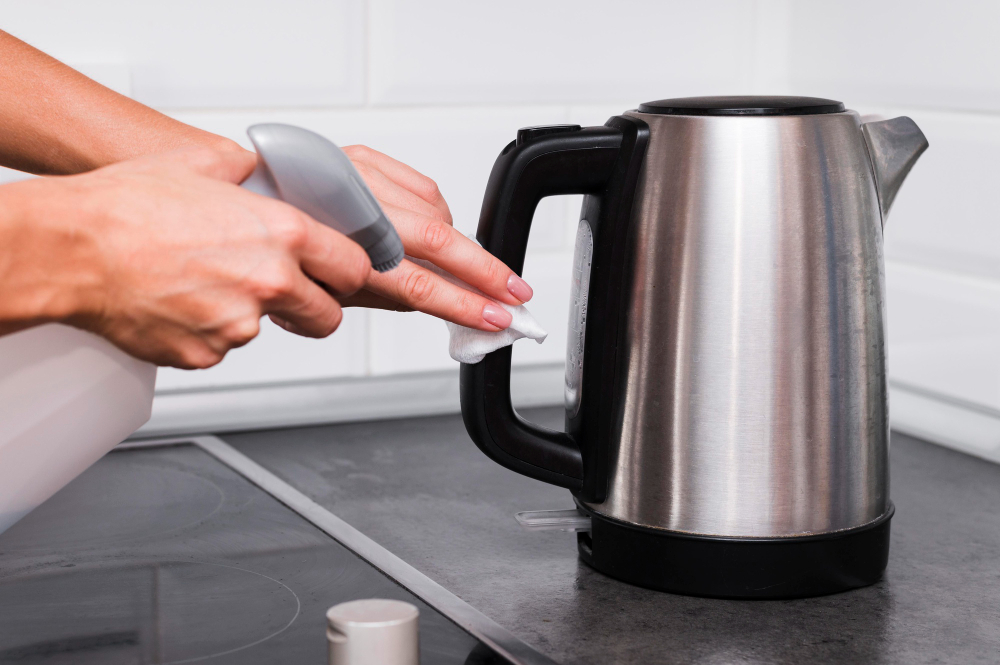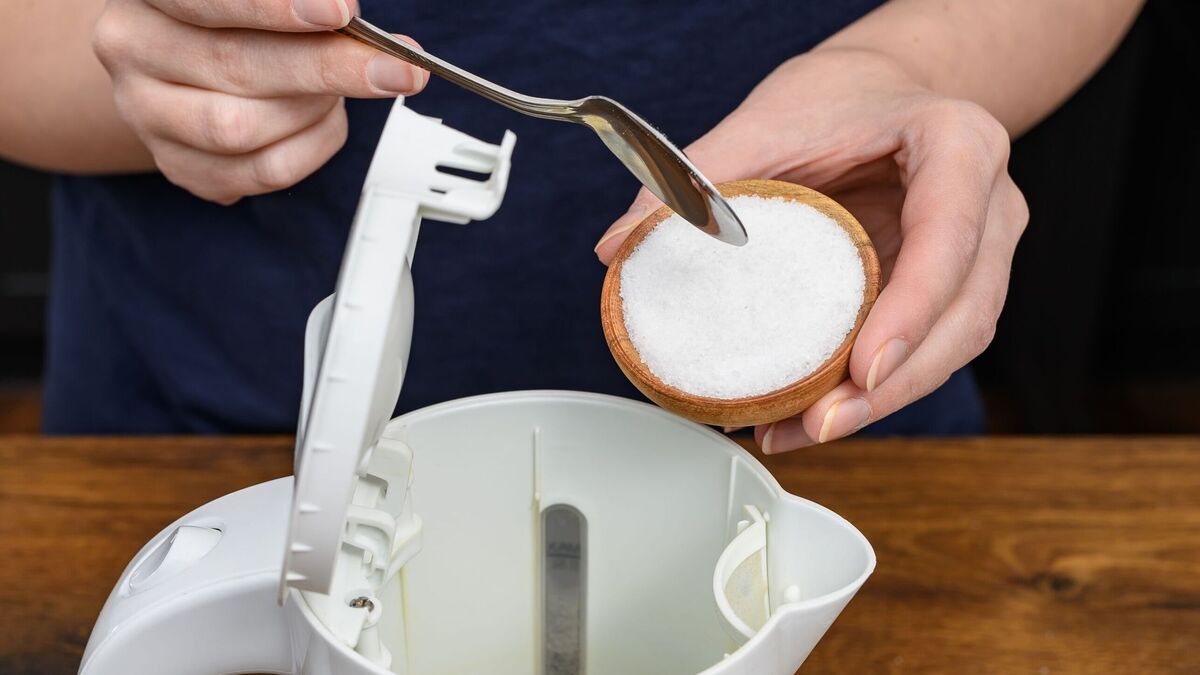How to Get Limescale Out of The Kettle

One of the most commonly used appliances in the kitchen is an electric kettle, as it is convenient to use. Rather than using a saucepan, pouring water into it, turning on the flame, and then waiting for the water to boil, a smarter approach is to use an electric kettle. Simply pour the water into it, turn it on, and the water boils quickly. However, with frequent use, limescale starts to build up in the kettle, which affects the taste of boiling water. And that is when we start looking for ways on how to get limescale out of the kettle.
Limescale not only affects the taste of water but also slows down the heating process, thus making it less energy efficient, and affects the performance. Hard water is one of the main reasons for limescale building up in the kettle. It is rich in calcium and magnesium, and when such water is heated and evaporates, it builds limescale in the kettle. If you live in an area with a hard water supply, then you might have noticed more accumulation of limescale in your kettle.
But not to worry much about this, by following the right methods you can easily descale the limescale out of the kettle. This guide uncovers some of the proven methods with step-by-step procedure on how to get limescale out of the kettle.
One of the most commonly used appliances in the kitchen is an electric kettle, as it is convenient to use. Rather than using a saucepan, pouring water into it, turning on the flame, and then waiting for the water to boil, a smarter approach is to use an electric kettle. Simply pour the water into it, turn it on, and the water boils quickly. However, with frequent use, limescale starts to build up in the kettle, which affects the taste of boiling water. And that is when we start looking for ways on how to get limescale out of the kettle.
Limescale not only affects the taste of water but also slows down the heating process, thus making it less energy efficient, and affects the performance. Hard water is one of the main reasons for limescale building up in the kettle. It is rich in calcium and magnesium, and when such water is heated and evaporates, it builds limescale in the kettle. If you live in an area with a hard water supply, then you might have noticed more accumulation of limescale in your kettle.
But not to worry much about this, by following the right methods you can easily descale the limescale out of the kettle. This guide uncovers some of the proven methods with step-by-step procedure on how to get limescale out of the kettle.
How to Get Limescale Out of The Kettle
Here are some of the effective ways of how to get limescale out of the kettle by using simple remedies without damaging it
Method 1: Vinegar-A Natural Remedy
Vinegar is commonly used for cleaning and removing stains. It is also very good at dissolving hard material residues.
What You Need
- White Vinegar
- Water
- Cleaning Cloth
Steps
- Fill the kettle halfway by adding equal amounts of water and white vinegar.
- Then turn the kettle on.
- Boil the solution.
- When it’s boiled, let it sit for 30 minutes. If you have more limescale build-up then you can leave it for 60 minutes.
- Discard that solution and use a cleaning cloth if there are any residues left, and rinse the kettle twice.
- Now fill the kettle with water only and bring it to a boil to eradicate any lingering taste of vinegar and then discard that water.
Method 2: Lemon Juice-A Fresh Alternative
Lemon juice is an excellent and natural way to clean limescale. The acid in the lemon juice helps to descale the limescale.
You Need
- Lemon/ Lemon Juice
- Water
- Cleaning Cloth
Steps
- Take 1 medium-sized or 2 small lemons and squeeze out their juice.
- Add water to the kettle and fill it halfway.
- Then add lemon juice to it.
- Turn on the kettle and boil the mixture of lemon juice and water.
- Leave it for 20-30 minutes.
- Then discard this mixture and wipe away leftover residues with a clean cloth and rinse the kettle thoroughly.
For their remedy, you can also use bottled lemon juice, but natural juice is the best.

Method 3: Citric Acid- The Effective Descaler
The next remedy in how to get limescale out of the kettle is the use of citric acid. Citric acid is an excellent cleaning agent; when dissolved with water, it helps to break down the limescale.
You Need
- Critic Acid
- Water
- Cleaning Cloth
Steps
- Fill the kettle halfway with water.
- Add 1-2 tbsp of citric acid and gently stir it.
- Switch on the kettle and let this solution boil.
- Then leave it for 15-20 minutes.
- Discard the solution and then wipe any residues with a cleaning cloth.
- Rinse the kettle thoroughly with water.
Method 4: Baking Soda-A Natural Cleaner and Deodorizer
Baking soda is commonly used in homes for cleaning. It is a natural deodorizer and whitener. It is also very helpful in descaling the limescale.
You Need
- Baking soda
- Water
- Cleaning Cloth
Steps
- Add 1-2 tbsp of baking soda to the kettle and fill it halfway with water.
- Turn on the kettle to boil the mixture of baking soda and water.
- Leave it for 20-30 minutes.
- Discard the mixture and wipe any residue with a cleaning cloth.
- Rinse the kettle thoroughly with water.
If there are stubborn deposits of limescale, then you can also add 1 tbsp of white vinegar along with water.
Method 5: Commercial Descaler-The Power Cleaner
A quick and fast way to remove the limescale from the kettle is the use of a commercial descaler. They have special ingredients that help to dissolve the limescale without damaging the kettle.
You Need
Commercial Descaler
Steps
All you have to do is follow the label instructions to descale the limescale and then clean the kettle thoroughly.
How Often Should You Descale Your Kettle
Now that you know how to get limescale out of the kettle, you can easily remove the buildup up limescale. Generally, it’s good to descale your kettle every 4-5 weeks but for hard water, you may need to descale every 2-3 weeks as hard water creates more limescale.
Other things that you need to note when it’s time to descale your kettle:
- If you see water get cloudy and is not clear after boiling.
- If you notice any change in the taste of water after boiling.
- If you notice any white deposits at the bottom of the kettle.
It also depends on the quality of the kettle; a good one might not need more frequent descaling. So when buying a kettle, make sure not to compromise on the quality and buy a good one.

How to Prevent Limescale Build-Up
Along with learning how to get limescale out of the kettle, you should also know how to prevent limescale from building up in the kettle so that you may not require frequent descaling:
- Always use filtered or distilled water. Filtered water has fewer minerals, which do not cause more limescale to build up in your kettle.
- Do not leave water for a longer time inside the kettle after boiling. Leaving the water in the kettle causes the minerals to deposit and creates limescale.
- Rinse the kettle after every use.
- Descale your kettle every month to prevent limescale from getting into it.
It is necessary to descale the limescale out of the kettle to keep it working efficiently. And it always doesn’t require the use of harsh chemicals. Simple and natural remedies like vinegar, lemon juice, and baking soda can effectively restore its shine without damaging it. These methods not only descale the limescale but also keep kettle safe for daily use.
Now that you have this easy and simple guide on how to get limescale out of the kettle, make descaling a regular part of your kitchen cleaning. Enjoy your hot drinks with pure and fresh taste!
Read Also: How to Clean Oven With Baking Soda?